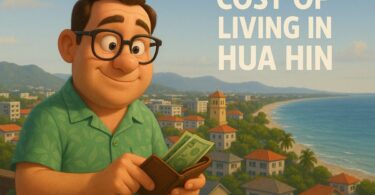In Thailand, bananas can be found growing everywhere. Some in the wild, others in gardens and farms. There are well over 50 varieties of Thai banana, however only 20 or so are actively cultivated. And of these just a handful are commonplace. Most are cultivated for eating. But some are grown for their leaves, as a decorative plant and for packaging.
Thai banana plants have become a popular addition to gardens in many countries. Including southern US states where the temperate climate suits them. But it’s important at this point to make a distinction. The Thai banana trees that can be bought overseas are ‘Musa Black Banana Plants’ (Musa balbisiana) These are not the type of bananas that are grown in Thailand for food.
What are Musa Black Thai Banana Plants?
Musa Black Banana Plants are what is commonly referred to, incorrectly, as Thai bananas. In fact this plant is an ancestor of the cultivated bananas that are grown for food Thailand today. In fact, if you are thinking of buying one of these plants for the fruit . . . don’t. The fruit, the actual banana, isn’t particularly good and the ‘bananas’ don’t look like the bananas you’re used to eating.
The Thai banana plant is sold purely because it grows in much larger clumps than other bananas and so it’s lush leaves provide ample shade and privacy in a garden. It is also much taller than cultivated plants, and can reach 6 metres (20 feet) in height.
Musa Balbisiana plants are still grown in Thailand, but for their leaves. The leaves of any banana plant can be used for many things. For example: as a serving plate; a food wrapping; a basic roofing material or even to make floating lanterns during the Loy Krathong festival. As Musa Black Banana Plants have both more and larger leaves than normal banana plants they are cultivated for this reason in some areas of the country.
How to Grow Thai Banana Plants
At this point it’s worth pointing out that bananas aren’t technically trees. The plant is classified as a type of herb. This is due to the way that it grows. The stem of a banana plant isn’t the same as the trunk of an apple tree for example. All the leaves and the fruit start out inside the stem and gradually grow up and out. Over time the external, older leaves die and fall off the plant.
It is possible to stick a banana in the ground and it will grow. However, as modern day bananas have been bred to be virtually seedless this isn’t usually possible. That is why you’ll see garden centres selling banana plant rhizomes (basically the equivalent of a bulb) which can be planted.
Here in Thailand there’s no complicated way of growing bananas. You stick them in the ground and then wait. They are very hardy and will grow in pretty much any conditions. The main requirements are plenty of sunshine, warm temperatures (18 – 35C / 65 – 95F ) and moist, but not flood-prone land. However, if you are buying them as a plant for the garden at home, consult your local garden center as they’ll be able to advise on suitability for the soil and climate.
The Most Popular Type of Banana in Thailand
If you want to buy and grow a real Thai banana plant, then the strain you have to look for is (Musa acuminata x balbisiana (ABB)) . That’s the latin name for what Thai people call Gluay Naam Waa. This is the most popular type of banana found in Thailand. It’s also a type of banana looks very different the the type which is usually sold in supermarkets in the US and Europe.
The large yellow bananas you’re used to are called ‘Cavendish‘. They have been bred for their uniform size and lack of seeds. The downside is that it has lost a lot of it’s natural banana flavour.
You probably won’t notice that though until you actually compare a Cavendish banana with a Gluay Naam Waa Thai banana. What you will have to do though is a blind taste test. As although Gluay Naam Waa are used for making fried bananas, grilling or just eating out of hand, they look very different.
They are much shorter, around 13cm / 5 inches long, and plumper. The skin is yellowy/green but is faded. It doesn’t have that lush, shiny look your supermarket Cavendish banana has. This strain of banana is now also grown in Mexico and is imported into the USA, where it’s especially popular with the Asian communities in Los Angeles.
Where to Find Bananas in Thailand?
If you visit Thailand or any Southeast Asian country, you’re going to see lots of exotic fruits. And bananas are everywhere. At home you’re probably used to seeing bananas for sale in supermarkets. But here they’re as common as a backyard apple tree in the US. Here on Koh Chang, I walk past a dozen wild banana plants on my way to the beach. They are farmed, but because they are so easy to grow virtually anywhere, people plant them in their back garden. They grow like ( very large) weeds. Free fruit and also a good surplus that can be sold.
This is why you’ll find Thai bananas for sale not only in supermarkets and fresh markets, but also on roadside stalls. And in some restaurants. And in places as diverse as car repair shops, pharmacies or tailors. Basically, anyone who has a banana plant will sell some at some time during the year.
Why? It’s not because Thais don’t enjoy eating bananas. It’s that a single tree can produce so much fruit that it’s hard for on family to consume it all. A typical banana plant might have a stem with 10- 15 tiers of bananas. Each tier having a hand of 15 – 20 bananas. So that’s 150, 200 or even 300 bananas that will be ripe simultaneously. That’s a whole lot of fruit to eat through.
How are Thai Bananas Used?
Here are various ways that bananas are used in Thailand.
For eating
Obviously. :-) But they are either fried or grilled more often than they are eaten fresh.
Fried bananas are made by simply slicing the banana lengthwise into strips. Then covering them in a sweet batter, often containing coconut milk and peanuts. These fried bananas are sold at roadside stalls across Thailand. In the Larn Luang area of central Bangkok there’s even a few streets that are famous for their traffic jam fried bananas. The traffic is so bad that vendors walk along the lines of traffic and sell then to commuters sitting in their cars. A great snack to munch on whilst waiting for the lights to change.
Grilled bananas are also popular and a little healthier. Bananas are sliced and then skewered, similar to satay. They are then placed on a charcoal grill to slowly cook. Once done, the pieces are squished slightly and then eaten with a sweet, caramel-like sauce, which is made form coconut milt, palm sugar and oil.
In tourist areas the Thai banana roti is ubiquitous. There’s always a guy with a roadside stall serving up fresh rotis. It is a type of thin pancake, cooked on a hot plate in front of you, and filled with sliced banana. It will often be topped with chocolate sauce or condensed milk. Likewise the more westernized banana pancake has long been a staple of backpacker haunts in Thailand and across southeast Asia. Back in he 1980s, the popular overland backpacking route from India was known as the ‘Banana pancake trail‘.
The large purple flower of the banana plant is also used to make salads. A typical banana flower salad usually includes some prawns, pork, tomato, carrot, shallots, peanuts and red curry paste. used fibrous and doesn’t have much taste. The outer leaves of the banana flower are sliced thinly and have a nondescript but slightly bitter taste. You’d never know it was a banana flower just from the taste. )
For wrapping & serving
In Thailand, banana leaves don’t go to waste.
Even nowadays Thai banana leaves are used for wrapping other foods. There are many types of Thai steamed rice snacks. These are cooked by placing ingredients in a small banana leaf parcel and steaming them. The leaves keep the moisture in and allow you to eat the snack without getting your hands dirty. It’s important to remember that you don’t eat the banana leaf wrapping. Only what’s inside. Banana leaves are the original eco-friendly packaging material.
In some restaurants they are also used in lieu of plates. Diners have a section of banana leaf placed on the table and food is placed on that. At the end of the mean you just dispose of your banana leaf plate in the composter. No washing up required.
As part of an ancient tradition
At full moon in November, Buddhists in Thailand celebrate the Loy Krathong festival.
This is an ancient festival where people pay their respects to the water gods. And recognize the importance of having a bountiful supply of fresh water. Thais across the country will go to the nearest river, pond or lake and release a decorated banana float in tribute to the spirits.
This float is traditionally made from the stem and leaves of a banana tree. A circular disc of stem is used as the base of the float. Banana leaves are made into intricate shapes. These, along with jasmine and other flowers, are used to decorate the float.

For Muay Thai training
Well not usually. But here’s one of Thailand’s most famous Muay Thai fighters beating up a banana plant. If you haven’t tried kicking a banana tree before, don’t try this at home. :-)








